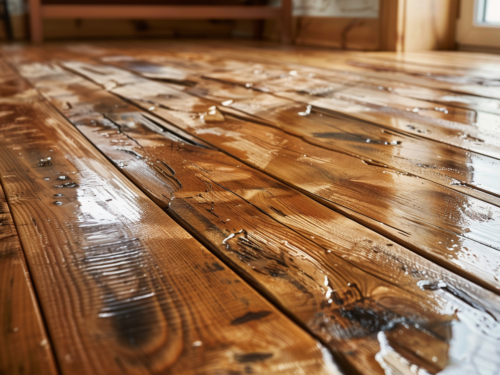
How does humidity affect hardwood flooring?
Hardwood flooring is a beautiful and durable option for many homes. However, it is important to understand how humidity can affect hardwood flooring. This will help you take care of your floors and keep them looking great for years to come. So to help steer you in the right direction with the maintenance and care of your hardwood flooring, let’s break down the answer to the question: How does humidity affect hardwood flooring?
What is Humidity?
First, let’s talk about what humidity is. Humidity is the amount of moisture or water vapor in the air. It can be measured with a hygrometer. When the air has a lot of moisture, the humidity is high. When the air is dry, the humidity is low. Humidity can change with the weather and the seasons.
How Humidity Affects Hardwood Flooring
Now, let’s see how humidity affects hardwood flooring. Wood is a natural material, which means it can absorb and release moisture. When the humidity is high, the wood absorbs moisture and expands. When the humidity is low, the wood releases moisture and contracts. This constant change can cause problems with your hardwood floors.
1. Expanding and Contracting
One of the main ways humidity affects hardwood flooring is by causing it to expand and contract. When the wood expands, it can cause the floorboards to push against each other. This can create pressure and make the boards buckle or warp. On the other hand, when the wood contracts, gaps can form between the floorboards. These gaps can make your floor look uneven and can let dirt and debris get trapped between the boards.
2. Cupping and Crowning
Another way humidity affects hardwood flooring is by causing cupping and crowning. Cupping happens when the edges of the floorboards are higher than the center. This can happen when the bottom of the wood absorbs more moisture than the top. Crowning is the opposite. It happens when the center of the floorboards is higher than the edges. This can occur when the top of the wood absorbs more moisture than the bottom. Both cupping and crowning can make your floor look wavy and can be uncomfortable to walk on.
3. Cracking and Splitting
Humidity can also cause hardwood floors to crack and split. When the wood absorbs too much moisture, it can swell and become too large for the space it is in. This can cause the wood to crack. Similarly, when the wood loses too much moisture, it can shrink and become brittle. This can also lead to cracking and splitting.
How to Protect Your Hardwood Flooring
Understanding how humidity affects hardwood flooring is important. Now, let’s talk about how to protect your floors from humidity-related problems. Here are some tips to help you keep your hardwood floors in great shape.
1. Maintain a Consistent Humidity Level
One of the best ways to protect your hardwood floors is to maintain a consistent humidity level in your home. The ideal humidity level for hardwood flooring is between 35% and 55%. You can use a hygrometer to measure the humidity in your home. If the humidity is too high, you can use a dehumidifier to remove excess moisture from the air. If the humidity is too low, you can use a humidifier to add moisture to the air.
2. Use Proper Ventilation
Proper ventilation is also important for maintaining a consistent humidity level. Make sure your home is well-ventilated, especially in areas where there is a lot of moisture, such as the kitchen and bathroom. Use exhaust fans to remove excess moisture from the air. Open windows and doors to let fresh air in and help regulate the humidity.
3. Install a Vapor Barrier
When installing hardwood flooring, it is a good idea to use a vapor barrier. A vapor barrier is a material that helps prevent moisture from getting into the wood. It is usually placed between the subfloor and the hardwood flooring. This can help protect your floors from moisture-related problems, such as cupping and crowning.
4. Control Temperature
In addition to controlling humidity, it is also important to control the temperature in your home. Extreme temperature changes can cause the wood to expand and contract, leading to problems like cracking and splitting. Keep your home at a consistent temperature to help protect your hardwood floors.
5. Regular Maintenance
Regular maintenance is key to keeping your hardwood floors in great shape. Clean your floors regularly to remove dirt and debris. Use a damp mop to clean the floors, but avoid using too much water, as this can cause the wood to absorb moisture. If you notice any signs of moisture-related problems, such as buckling or gaps, address them right away.
Humidity & Hardwood Flooring
In conclusion, humidity can have a big impact on hardwood flooring. It can cause the wood to expand and contract, leading to problems like buckling, gaps, cupping, crowning, and cracking. However, by maintaining a consistent humidity level, using proper ventilation, installing a vapor barrier, controlling the temperature, and performing regular maintenance, you can protect your hardwood floors and keep them looking beautiful for years to come.
Remember, taking care of your hardwood flooring is important. By understanding how humidity affects hardwood flooring and taking the necessary steps to protect your floors, you can enjoy the beauty and durability of hardwood flooring in your home for many years.


